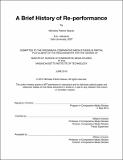| dc.contributor.advisor | William Uricchio. | en_US |
| dc.contributor.author | Seaver, Nicholas Patrick | en_US |
| dc.contributor.other | Massachusetts Institute of Technology. Dept. of Comparative Media Studies. | en_US |
| dc.date.accessioned | 2010-10-29T13:54:10Z | |
| dc.date.available | 2010-10-29T13:54:10Z | |
| dc.date.copyright | 2010 | en_US |
| dc.date.issued | 2010 | en_US |
| dc.identifier.uri | http://hdl.handle.net/1721.1/59573 | |
| dc.description | Thesis (S.M.)--Massachusetts Institute of Technology, Dept. of Comparative Media Studies, 2010. | en_US |
| dc.description | This electronic version was submitted by the student author. The certified thesis is available in the Institute Archives and Special Collections. | en_US |
| dc.description | Cataloged from student submitted PDF version of thesis. | en_US |
| dc.description | Includes bibliographical references (p. 93-97). | en_US |
| dc.description.abstract | Discussions of music reproduction technology have generally focused on what Jonathan Sterne calls "tympanic" reproduction: the recording and playback of sounds through microphones and speakers. While tympanic reproduction has been very successful, its success has limited the ways in which music reproduction is popularly imagined and discussed. This thesis explores the history of "re-performance," an alternative mode of reproduction epitomized by the early twentieth-century player piano. It begins with a discussion of nineteenth-century piano recorders and the historical role of material representation in the production of music. It continues with the advent of player pianos in the early twentieth century that allowed users to "interpret" prerecorded material, blurring the line between performance and reproduction and inspiring popular reflection on the role of the mechanical in music. It concludes with the founding of the American Piano Company laboratory in 1924 and the establishment of a mechanically founded rhetoric of fidelity. Bookending this history is an account of a performance and recording session organized by Zenph Studios, a company that processes historical tympanic recordings to produce high-resolution data files for modern player pianos. Zenph's project appears futuristic from the perspective of tympanic reproduction, but is more readily understood in terms of the history of re-performance, suggesting a need for renewing critical attention on re-performative technologies. Contemporary developments in music reproduction such as music video games and sampling may make new sense considered in the context of re-performance. This alternative history aims to provide a ground on which such analysis could be built. | en_US |
| dc.description.statementofresponsibility | by Nicholas Patrick Seaver. | en_US |
| dc.format.extent | 97 p. | en_US |
| dc.language.iso | eng | en_US |
| dc.publisher | Massachusetts Institute of Technology | en_US |
| dc.rights | M.I.T. theses are protected by
copyright. They may be viewed from this source for any purpose, but
reproduction or distribution in any format is prohibited without written
permission. See provided URL for inquiries about permission. | en_US |
| dc.rights.uri | http://dspace.mit.edu/handle/1721.1/7582 | en_US |
| dc.subject | Comparative Media Studies. | en_US |
| dc.title | A brief history of re-performance | en_US |
| dc.type | Thesis | en_US |
| dc.description.degree | S.M. | en_US |
| dc.identifier.oclc | 670237330 | en_US |
